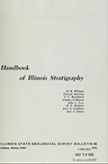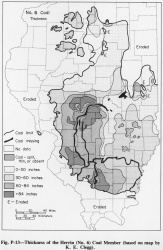Historical:Herrin Coal Member
Lithostratigraphy: Kewanee Group >>Carbondale Formation >>Herrin Coal Member
Chronostratigraphy: Paleozoic Erathem >>Pennsylvanian Subsystem >>Desmoinesian Series
Allostratigraphy: Absaroka Sequence
Authors
M. E. Hopkins and J. A. Simon
Name Origin
The Herrin (No. 6) Coal Member of the Carbondale Formation was originally named No. 6 Coal (Worthen, 1870, p. 93) and later called Herrin (No. 6) Coal (Shaw and Savage, 1912, p. 6) for Herrin, Williamson County, where the coal is extensively mined. It formerly was called the Brereton (No. 6) coal in western Illinois, the "Second Vein" (No. 5) coal in the La Salle area, and the Streator (No. 7) coal in the Streator area.
Correlation
The coal extends into western Indiana, where it is now called the Herrin Coal Member. It is extensively mined in western Kentucky, where it is known as the No. 11 coal, and it is correlated with the Lexington coal in Missouri and the Mystic Coal Member in Iowa.
Extent and Thickness
The Herrin Coal is present throughout much of the area of Pennsylvanian rocks (fig. P-13). It averages more than 6 feet thick in extensive areas and locally reaches 15 feet. It is thin in much of central Illinois but has been extensively mined in western, west-central, southern, and northern Illinois, as well as in the southern part of the Danville region of eastern Illinois. In some places the coal is cut out by channels filled with the Anvil Rock Sandstone Member.
Description
The coal is a normal bright-banded coal. Its lower portion contains a prominent claystone parting (the "blue band") that normally is 1-3 inches thick. In parts of Illinois, silty gray shale as much as 100 feet thick overlies the Herrin Coal. Associated with this shale is a channel sandstone commonly as much as a mile wide and 60-80 feet thick that was mapped as Anvil Rock Sandstone (Hopkins, 1958; Potter and Simon, 1961), but later unpublished studies suggest that it may be in part contemporaneous with the coal. In areas where the coal is overlain by relatively thick bodies of the gray shale, the coal generally varies in thickness, locally contains gray shale lenses up to a few tens of feet thick, and has a much lower sulfur content than it does elsewhere (Gluskoter and Simon, 1968; Gluskoter and Hopkins, 1970). The gray shale overlies the coal in four areas, principally in parts of the following counties: (1) Williamson, Franklin, and Jefferson, (2) Madison and St. Clair, (3) eastern Macoupin, and (4) southern Vermilion. Except in these areas the Herrin Coal is generally overlain by either the Anna Shale Member (black fissile shale) or the Brereton Limestone Member. The Herrin Coal rests on a well developed underclay.
References
GLUSKOTER, H. J., and M. E. HOPKINS, 1970, Distribution of sulfur in Illinois coals: Illinois State Geological Survey Guidebook Series 8, p. 89-95.
GLUSKOTER, H. J., and J. A. SIMON, 1968, Sulfur in Illinois coals: Illinois State Geological Survey Circular 432, 28 p.
HOPKINS, M. E., 1958, Geology and petrology of the Anvil Rock Sandstone of southern Illinois: Illinois State Geological Survey Circular 256, 49 p.
POTTER, P. E., and J. A. SIMON, 1961, Anvil Rock Sandstone and channel cutouts of Herrin (No. 6) Coal in west-central Illinois: Illinois State Geological Survey Circular 314, 12 p.
SHAW, E. W., and T. E. SAVAGE, 1912, Murphysboro and Herrin Quadrangles: USGS Geological Atlas Folio 185.
WORTHEN, A. H., 1870, Geology and paleontology: Geological Survey of Illinois, v. 4, 508 p.
ISGS Codes
| Stratigraphic Code | Geo Unit Designation |
|---|---|

